power steering FIAT BARCHETTA 2003 1.G Owners Manual
[x] Cancel search | Manufacturer: FIAT, Model Year: 2003, Model line: BARCHETTA, Model: FIAT BARCHETTA 2003 1.GPages: 170, PDF Size: 3.55 MB
Page 11 of 170
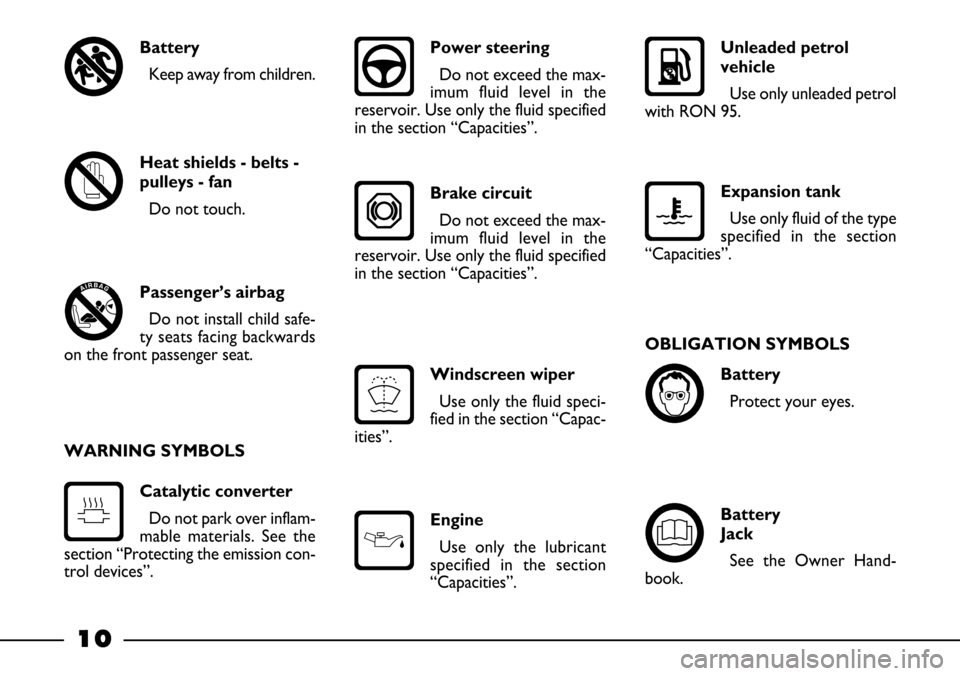
Unleaded petrol
vehicle
Use only unleaded petrol
with RON 95.
Expansion tank
Use only fluid of the type
specified in the section
“Capacities”.
Battery
Jack
See the Owner Hand-
book.Battery
Protect your eyes.
Engine
Use only the lubricant
specified in the section
“Capacities”. Windscreen wiper
Use only the fluid speci-
fied in the section “Capac-
ities”.Brake circuit
Do not exceed the max-
imum fluid level in the
reservoir. Use only the fluid specified
in the section “Capacities”.
Catalytic converter
Do not park over inflam-
mable materials. See the
section “Protecting the emission con-
trol devices”.Power steering
Do not exceed the max-
imum fluid level in the
reservoir. Use only the fluid specified
in the section “Capacities”.
Passenger’s airbag
Do not install child safe-
ty seats facing backwards
on the front passenger seat.Heat shields - belts -
pulleys - fan
Do not touch. Battery
Keep away from children.
10
WARNING SYMBOLSOBLIGATION SYMBOLS
Page 18 of 170
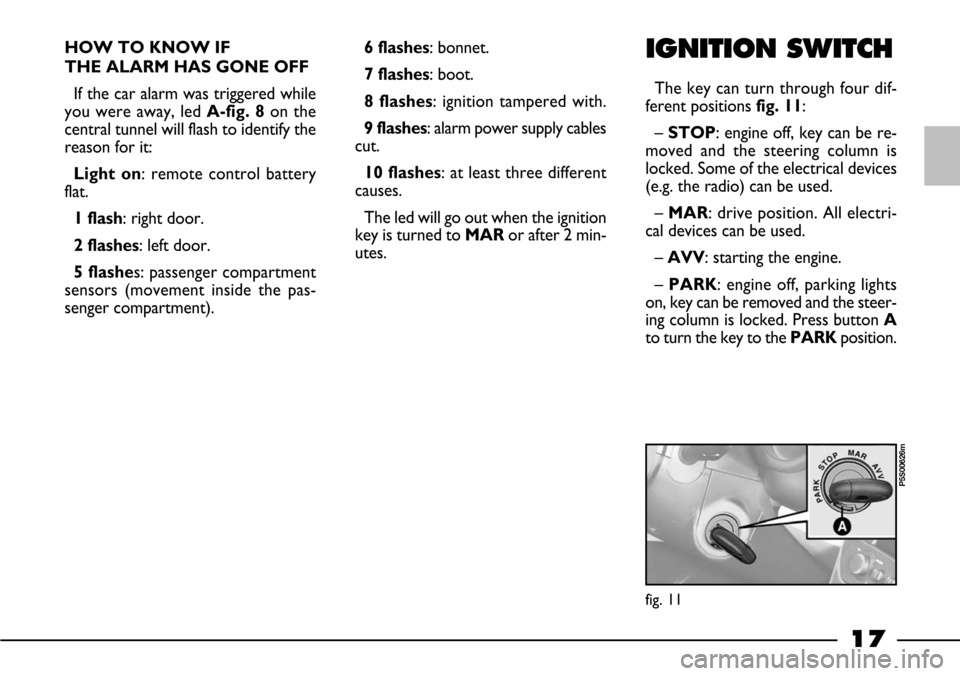
17
HOW TO KNOW IF
THE ALARM HAS GONE OFF
If the car alarm was triggered while
you were away, led A-fig. 8on the
central tunnel will flash to identify the
reason for it:
Light on: remote control battery
flat.
1 flash: right door.
2 flashes: left door.
5 flashes: passenger compartment
sensors (movement inside the pas-
senger compartment).6 flashes: bonnet.
7 flashes: boot.
8 flashes: ignition tampered with.
9 flashes: alarm power supply cables
cut.
10 flashes: at least three different
causes.
The led will go out when the ignition
key is turned toMARor after 2 min-
utes.IGNITION SWITCH
The key can turn through four dif-
ferent positions fig. 11:
– STOP: engine off, key can be re-
moved and the steering column is
locked. Some of the electrical devices
(e.g. the radio) can be used.
– MAR: drive position. All electri-
cal devices can be used.
– AVV: starting the engine.
– PARK: engine off, parking lights
on, key can be removed and the steer-
ing column is locked. Press button A
to turn the key to the PARKposition.
fig. 11
P5S00626m
Page 74 of 170
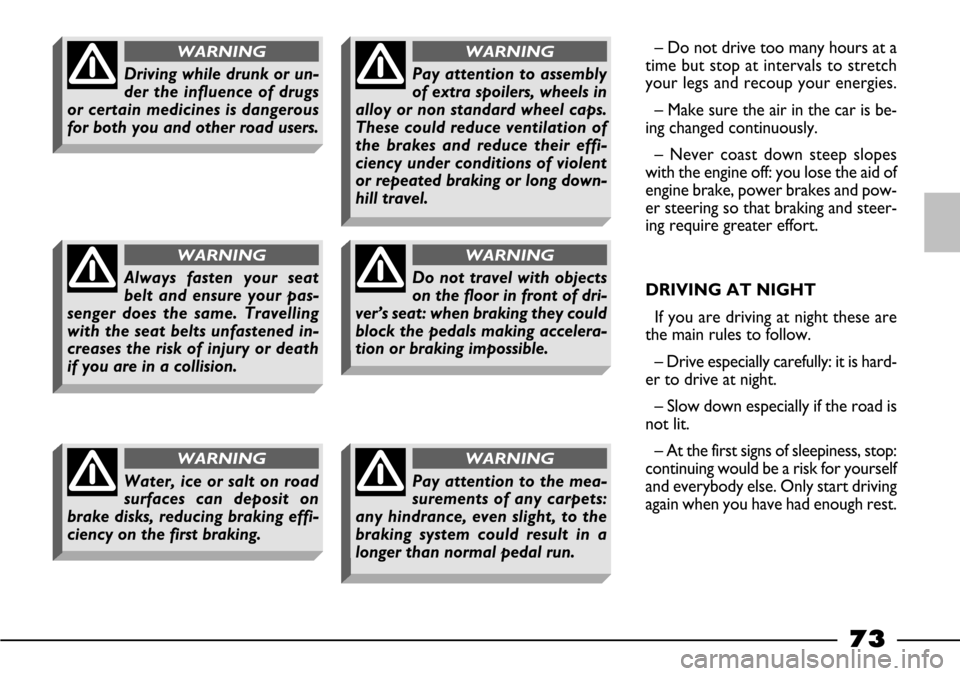
73
– Do not drive too many hours at a
time but stop at intervals to stretch
your legs and recoup your energies.
– Make sure the air in the car is be-
ing changed continuously.
– Never coast down steep slopes
with the engine off: you lose the aid of
engine brake, power brakes and pow-
er steering so that braking and steer-
ing require greater effort.
DRIVING AT NIGHT
If you are driving at night these are
the main rules to follow.
– Drive especially carefully: it is hard-
er to drive at night.
– Slow down especially if the road is
not lit.
– At the first signs of sleepiness, stop:
continuing would be a risk for yourself
and everybody else. Only start driving
again when you have had enough rest.
Driving while drunk or un-
der the influence of drugs
or certain medicines is dangerous
for both you and other road users.
WARNING
Always fasten your seat
belt and ensure your pas-
senger does the same. Travelling
with the seat belts unfastened in-
creases the risk of injury or death
if you are in a collision.
WARNING
Water, ice or salt on road
surfaces can deposit on
brake disks, reducing braking effi-
ciency on the first braking.
WARNING
Pay attention to assembly
of extra spoilers, wheels in
alloy or non standard wheel caps.
These could reduce ventilation of
the brakes and reduce their effi-
ciency under conditions of violent
or repeated braking or long down-
hill travel.
WARNING
Do not travel with objects
on the floor in front of dri-
ver’s seat: when braking they could
block the pedals making accelera-
tion or braking impossible.
WARNING
Pay attention to the mea-
surements of any carpets:
any hindrance, even slight, to the
braking system could result in a
longer than normal pedal run.
WARNING
Page 83 of 170
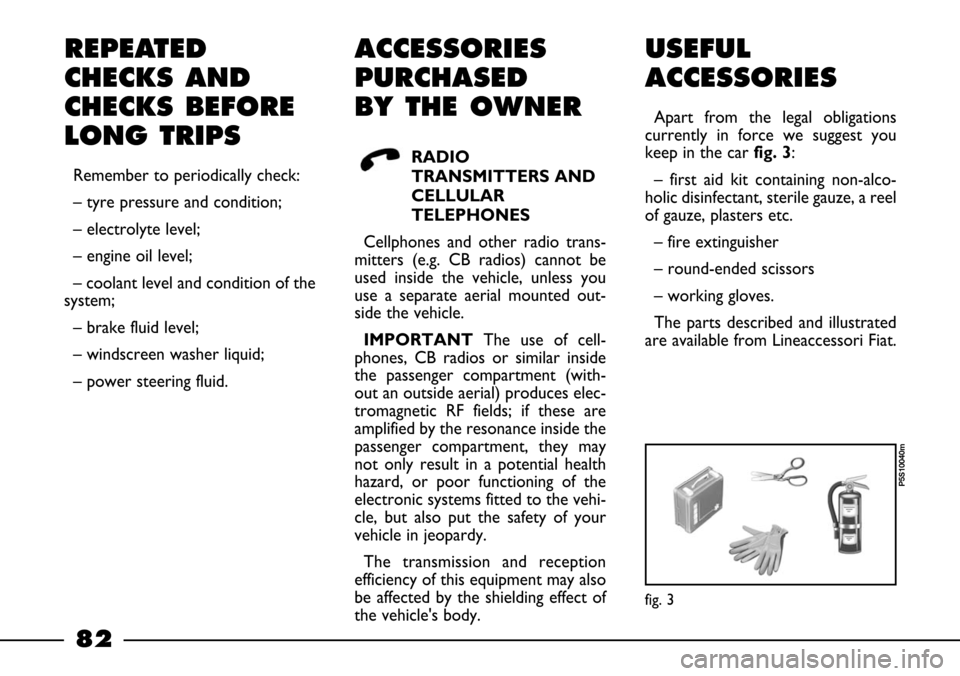
82
REPEATED
CHECKS AND
CHECKS BEFORE
LONG TRIPS
Remember to periodically check:
– tyre pressure and condition;
– electrolyte level;
– engine oil level;
– coolant level and condition of the
system;
– brake fluid level;
– windscreen washer liquid;
– power steering fluid.
ACCESSORIES
PURCHASED
BY THE OWNER
RADIO
TRANSMITTERS AND
CELLULAR
TELEPHONES
Cellphones and other radio trans-
mitters (e.g. CB radios) cannot be
used inside the vehicle, unless you
use a separate aerial mounted out-
side the vehicle.
IMPORTANTThe use of cell-
phones, CB radios or similar inside
the passenger compartment (with-
out an outside aerial) produces elec-
tromagnetic RF fields; if these are
amplified by the resonance inside the
passenger compartment, they may
not only result in a potential health
hazard, or poor functioning of the
electronic systems fitted to the vehi-
cle, but also put the safety of your
vehicle in jeopardy.
The transmission and reception
efficiency of this equipment may also
be affected by the shielding effect of
the vehicle's body.
USEFUL
ACCESSORIES
Apart from the legal obligations
currently in force we suggest you
keep in the car fig. 3:
– first aid kit containing non-alco-
holic disinfectant, sterile gauze, a reel
of gauze, plasters etc.
– fire extinguisher
– round-ended scissors
– working gloves.
The parts described and illustrated
are available from Lineaccessori Fiat.
fig. 3
P5S10040m
Page 109 of 170
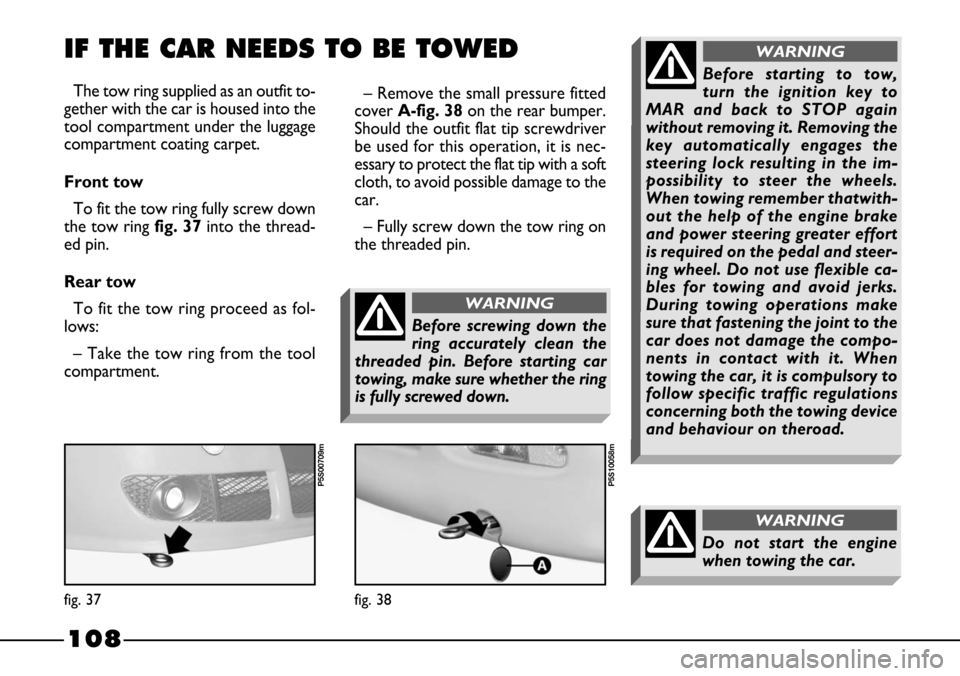
108
The tow ring supplied as an outfit to-
gether with the car is housed into the
tool compartment under the luggage
compartment coating carpet.
Front tow
To fit the tow ring fully screw down
the tow ring fig. 37into the thread-
ed pin.
Rear tow
To fit the tow ring proceed as fol-
lows:
– Take the tow ring from the tool
compartment.
IF THE CAR NEEDS TO BE TOWED
fig. 37
P5S00709m
fig. 38
P5S10058m
– Remove the small pressure fitted
cover A-fig. 38on the rear bumper.
Should the outfit flat tip screwdriver
be used for this operation, it is nec-
essary to protect the flat tip with a soft
cloth, to avoid possible damage to the
car.
– Fully screw down the tow ring on
the threaded pin.
Before screwing down the
ring accurately clean the
threaded pin. Before starting car
towing, make sure whether the ring
is fully screwed down.
WARNING
Do not start the engine
when towing the car.
WARNING
Before starting to tow,
turn the ignition key to
MAR and back to STOP again
without removing it. Removing the
key automatically engages the
steering lock resulting in the im-
possibility to steer the wheels.
When towing remember thatwith-
out the help of the engine brake
and power steering greater effort
is required on the pedal and steer-
ing wheel. Do not use flexible ca-
bles for towing and avoid jerks.
During towing operations make
sure that fastening the joint to the
car does not damage the compo-
nents in contact with it. When
towing the car, it is compulsory to
follow specific traffic regulations
concerning both the towing device
and behaviour on theroad.
WARNING
Page 116 of 170
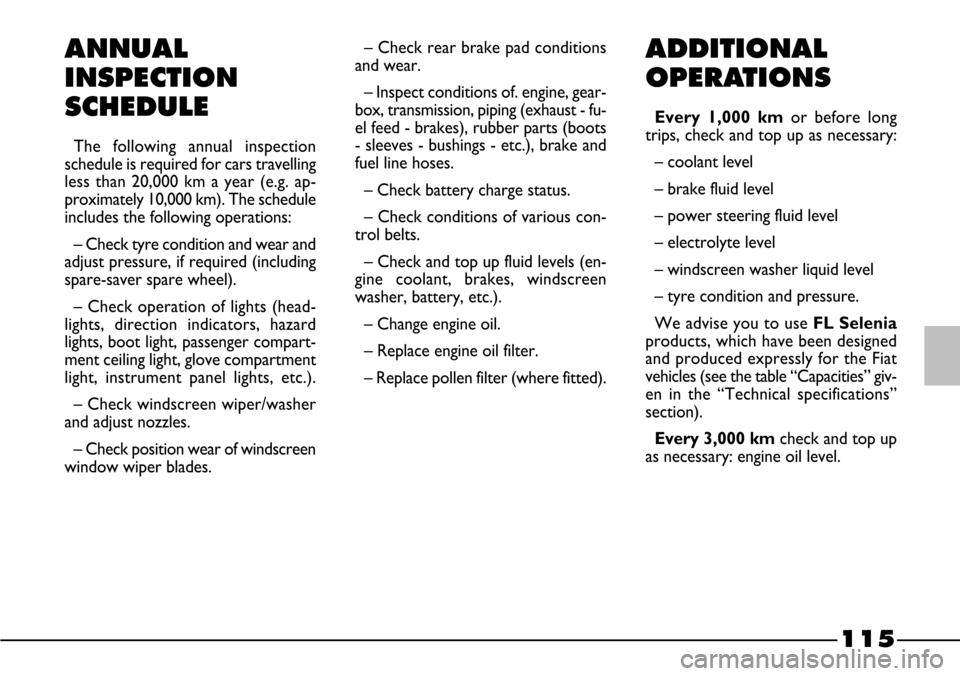
115
ANNUAL
INSPECTION
SCHEDULE
The following annual inspection
schedule is required for cars travelling
less than 20,000 km a year (e.g. ap-
proximately 10,000 km). The schedule
includes the following operations:
– Check tyre condition and wear and
adjust pressure, if required (including
spare-saver spare wheel).
– Check operation of lights (head-
lights, direction indicators, hazard
lights, boot light, passenger compart-
ment ceiling light, glove compartment
light, instrument panel lights, etc.).
– Check windscreen wiper/washer
and adjust nozzles.
– Check position wear of windscreen
window wiper blades.
ADDITIONAL
OPERATIONS
Every 1,000 kmor before long
trips, check and top up as necessary:
– coolant level
– brake fluid level
– power steering fluid level
– electrolyte level
– windscreen washer liquid level
– tyre condition and pressure.
We advise you to use FL Selenia
products, which have been designed
and produced expressly for the Fiat
vehicles (see the table “Capacities” giv-
en in the “Technical specifications”
section).
Every 3,000 km check and top up
as necessary: engine oil level. – Check rear brake pad conditions
and wear.
– Inspect conditions of. engine, gear-
box, transmission, piping (exhaust - fu-
el feed - brakes), rubber parts (boots
- sleeves - bushings - etc.), brake and
fuel line hoses.
– Check battery charge status.
– Check conditions of various con-
trol belts.
– Check and top up fluid levels (en-
gine coolant, brakes, windscreen
washer, battery, etc.).
– Change engine oil.
– Replace engine oil filter.
– Replace pollen filter (where fitted).
Page 118 of 170
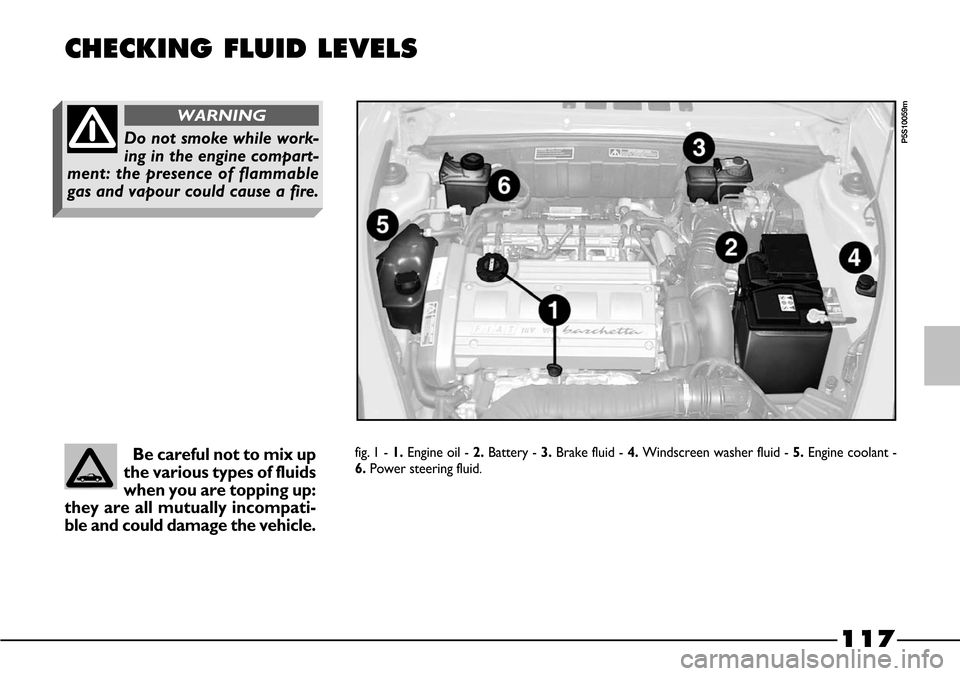
117
CHECKING FLUID LEVELS
P5S10059m
Be careful not to mix up
the various types of fluids
when you are topping up:
they are all mutually incompati-
ble and could damage the vehicle.fig. 1 -1. Engine oil - 2. Battery - 3. Brake fluid - 4. Windscreen washer fluid - 5. Engine coolant -
6. Power steering fluid.
Do not smoke while work-
ing in the engine compart-
ment: the presence of flammable
gas and vapour could cause a fire.
WARNING
Page 121 of 170
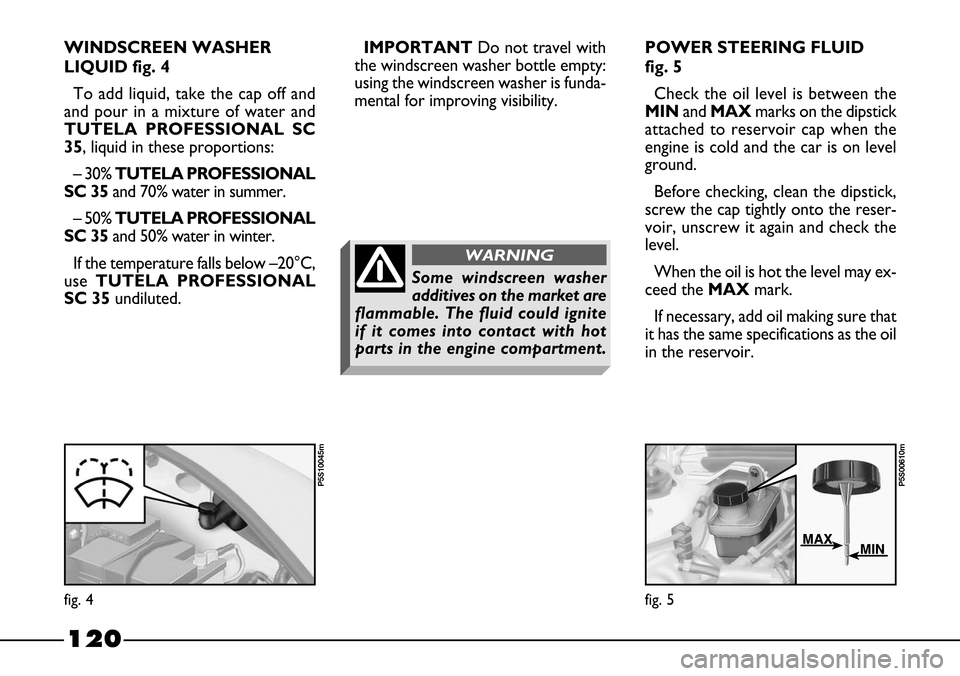
120
WINDSCREEN WASHER
LIQUID fig. 4
To add liquid, take the cap off and
and pour in a mixture of water and
TUTELA PROFESSIONAL SC
35, liquid in these proportions:
– 30% TUTELA PROFESSIONAL
SC 35and 70% water in summer.
– 50% TUTELA PROFESSIONAL
SC 35and 50% water in winter.
If the temperature falls below –20°C,
use TUTELA PROFESSIONAL
SC 35undiluted.POWER STEERING FLUID
fig. 5
Check the oil level is between the
MINand MAXmarks on the dipstick
attached to reservoir cap when the
engine is cold and the car is on level
ground.
Before checking, clean the dipstick,
screw the cap tightly onto the reser-
voir, unscrew it again and check the
level.
When the oil is hot the level may ex-
ceed the MAXmark.
If necessary, add oil making sure that
it has the same specifications as the oil
in the reservoir. IMPORTANT Do not travel with
the windscreen washer bottle empty:
using the windscreen washer is funda-
mental for improving visibility.
fig. 4
P5S10045m
fig. 5
P5S00610m
Some windscreen washer
additives on the market are
flammable. The fluid could ignite
if it comes into contact with hot
parts in the engine compartment.
WARNING
Page 129 of 170
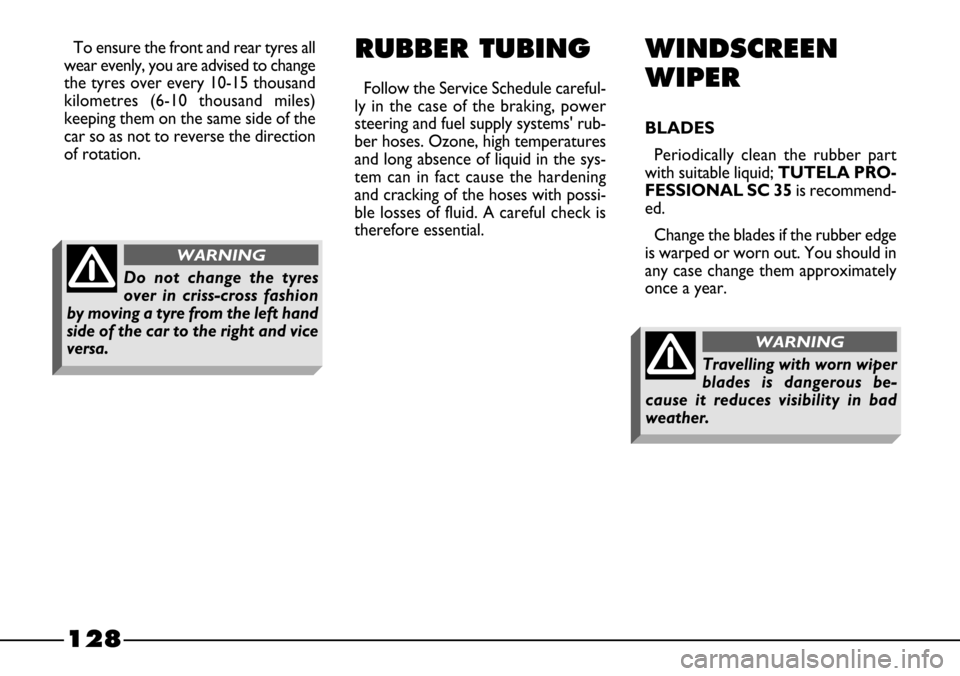
128
RUBBER TUBING
Follow the Service Schedule careful-
ly in the case of the braking, power
steering and fuel supply systems' rub-
ber hoses. Ozone, high temperatures
and long absence of liquid in the sys-
tem can in fact cause the hardening
and cracking of the hoses with possi-
ble losses of fluid. A careful check is
therefore essential.
WINDSCREEN
WIPER
BLADES
Periodically clean the rubber part
with suitable liquid; TUTELA PRO-
FESSIONAL SC 35is recommend-
ed.
Change the blades if the rubber edge
is warped or worn out. You should in
any case change them approximately
once a year. To ensure the front and rear tyres all
wear evenly, you are advised to change
the tyres over every 10-15 thousand
kilometres (6-10 thousand miles)
keeping them on the same side of the
car so as not to reverse the direction
of rotation.
Do not change the tyres
over in criss-cross fashion
by moving a tyre from the left hand
side of the car to the right and vice
versa.
WARNING
Travelling with worn wiper
blades is dangerous be-
cause it reduces visibility in bad
weather.
WARNING
Page 141 of 170
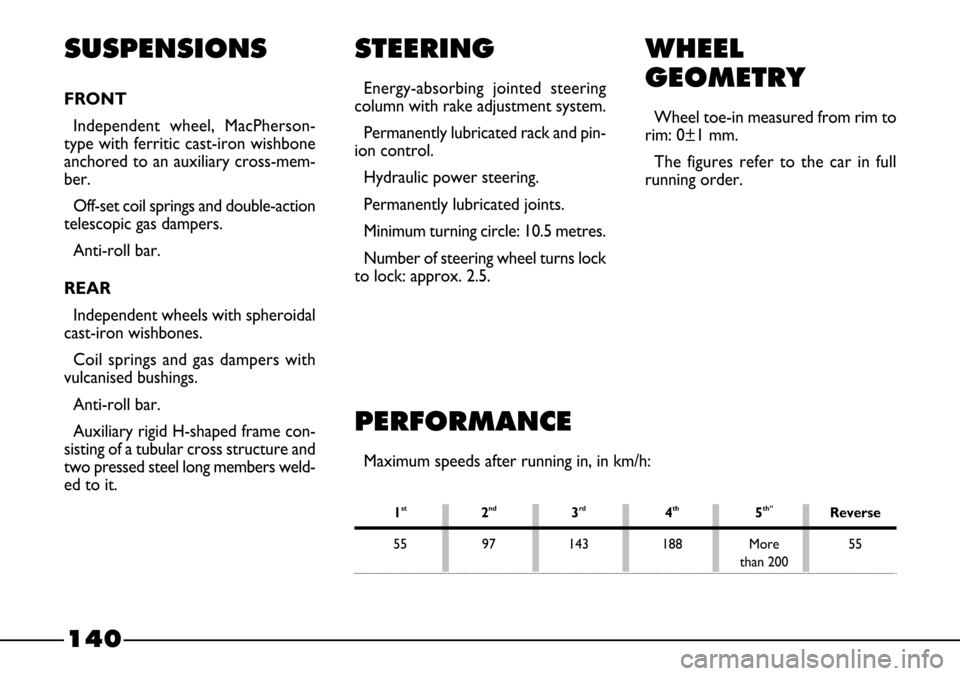
140
SUSPENSIONS
FRONT
Independent wheel, MacPherson-
type with ferritic cast-iron wishbone
anchored to an auxiliary cross-mem-
ber.
Off-set coil springs and double-action
telescopic gas dampers.
Anti-roll bar.
REAR
Independent wheels with spheroidal
cast-iron wishbones.
Coil springs and gas dampers with
vulcanised bushings.
Anti-roll bar.
Auxiliary rigid H-shaped frame con-
sisting of a tubular cross structure and
two pressed steel long members weld-
ed to it.
STEERING
Energy-absorbing jointed steering
column with rake adjustment system.
Permanently lubricated rack and pin-
ion control.
Hydraulic power steering.
Permanently lubricated joints.
Minimum turning circle: 10.5 metres.
Number of steering wheel turns lock
to lock: approx. 2.5.
WHEEL
GEOMETRY
Wheel toe-in measured from rim to
rim: 0±1 mm.
The figures refer to the car in full
running order.
PERFORMANCE
Maximum speeds after running in, in km/h:
1st2nd3rd 4th5th”Reverse
55 97 143 188 More 55
than 200